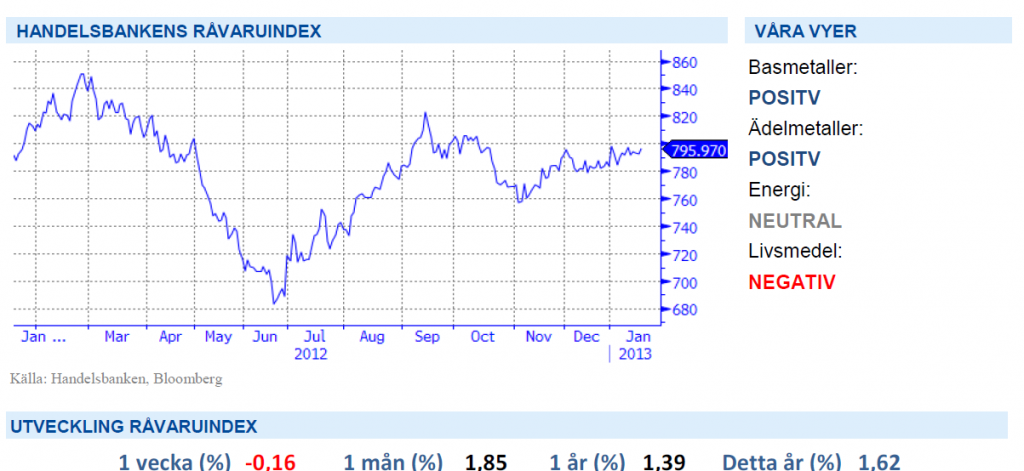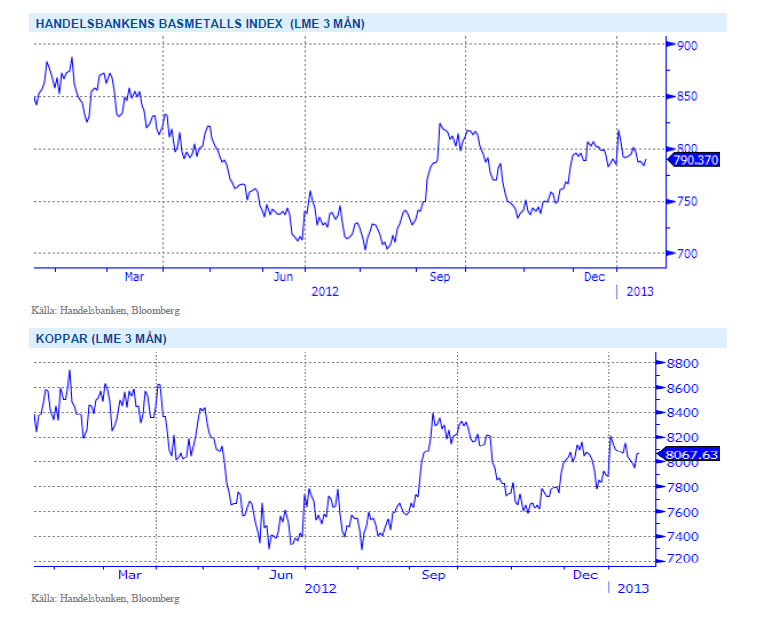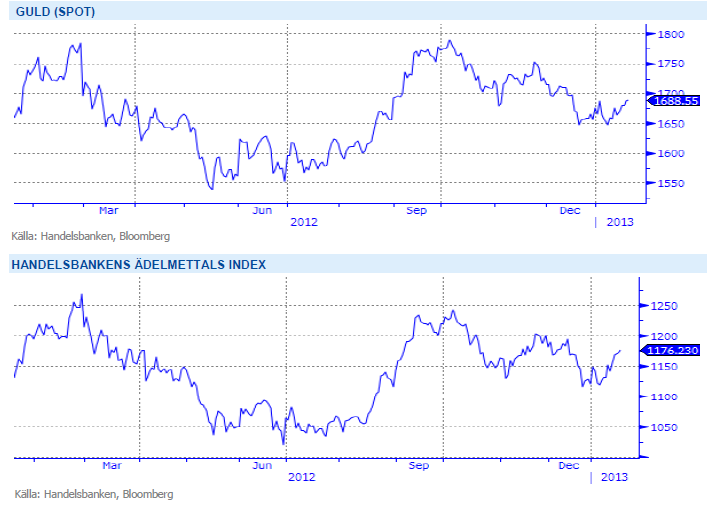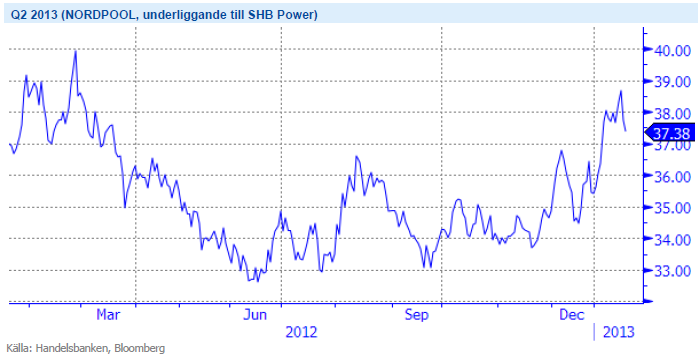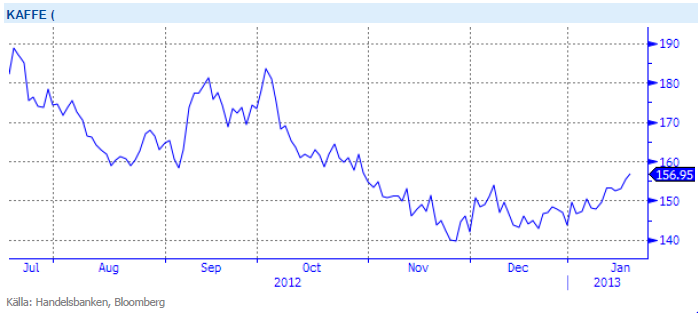Analys
SHB Råvarubrevet 18 januari 2013
 Allt fokus på USA
Allt fokus på USA
Vi håller fast vid en i grunden positiv syn på global makro i början på året, framförallt relaterat till Kina och USA. Synen på stigande riskaptit globalt ligger fast även om amerikansk politik kan hålla tillbaka något. Välkomna tecken på förbättringar i Kina kom denna vecka i form av BNP tillväxt för sista kvartalet på 7,9 %, upp från 7,4 % i Q3. Allt pekar nu på att botten i den kinesiska konjunkturcykeln var i september och att återhämtningen sprider sig.
Amerikanska konsumenter möter däremot stramare finanspolitik 2013. Förbättrade bo-, aktie- och arbetsmarknader ger dock framtidshopp. Aktiviteten inom industrin ser svagare ut än förväntat i inledningen på året trots att viss finanspolitisk osäkerhet skingrats. Risk finns att stundande finanspolitiska förhandlingar håller tillbaka aktiviteten fram till sista februari. Om inga nya överenskommelser kommer till stånd kommer skuldtaket slås vid mitten av februari eller något därefter, automatiska nedskärningar (0.5% av BNP) stundar den första mars, och den 27:e mars tvingas staten att stänga ned icke-essentiella områden
Basmetallerna
Lagerpåfyllnad och Kinas återhämtning i fokus
Kinas återhämtning har givit stöd åt metallmarknaden under hösten där man successivt byggt upp lager som betats av tidigare under året. Vi förväntar oss att uppgången fortsätter under första kvartalet även om ett skuldtyngt Europa samt diskussionerna kring USA’s skuldtak begränsar uppgången något. Blandade rörelser där nickel och koppar visat mest styrka och stigit med 3,4 respektive 1,94 %. Zink och aluminium har däremot tappat 2,5 % respektive 0,8 %.
Uppgången på koppar kom av sig och kontraktet handlades på 2-veckors lägsta efter att Barack Obama gick ut och varnade om en ekonomisk katastrof ifall kongressen misslyckas med att öka landets upplåningsgräns, men har nu återhämtat sig efter positiva försäljningssiffror från USA. Vi håller koppar som vår favorit bland basmetallerna, men ser positivt på hela sektorn under det kommande kvartalet
Med Kinas återhämtning i ryggen tror vi på stigande priser på basmetaller. Vi tror på: BASMET H
Ädelmetaller
Låga räntor stödjer ädelmetallerna
2012 avslutades med ganska stora prisrörelser för ädelmetaller, de avslutande veckorna förra året såg guldet falla med 4 procent, och silvret med hela 10 procent. Dessa fall har i stort sett återhämtats under inledningen av 2013, och vi håller kvar vid vår positiva syn. Dock är vi lite mindre övertygade för tillfället, och vi anser att man bör vara observant på utvecklingen de närmaste veckorna.
De underliggande orsakerna till vår positiva syn är alltjämt de extremt låga räntorna världen över, och den risk vi ser för stigande inflationsförväntningar framöver. Låga räntor gör ju som bekant att alternativkostnaden för att hålla guld blir låg, och sjunkande korta räntor har historiskt varit nära länkat till stigande guldpris. Samtidigt så har guldet visat sig vara ett mycket bra skydd mot inflation, och en tillgång som tenderat att fungera bra när det varit kriser och finansiell oro i världen.
Det vi ser nu när vi går in i 2013 är begynnande optimism om både återhämtning i Kina och USA, och möjligheter till en överenskommelse under februari när det gäller den amerikanska budgeten. Detta kan leda till viss kortsiktig press nedåt på guldpriset, så vi känner att det är bra att ”dansa nära nödutgången” när det gäller långa guldpositioner. Men – skulle Obama och republikanerna inte nå en överenskommelse, då kommer guldet sannolikt vara en vinnare.
Inför 2013 är vi fortsatt positiva till ädelmetaller. Fortsatt mjuk penningpolitik, svag makroekonomi, starkare efterfrågan från Kina och Indien och att centralbanker i utvecklingsekonomier köper guld gör att vi tror på: ADELMET H
Energi
Svagt för både el och utsläppsrätter
Sentimentet fortsätter ned på elmarknaden där kontraktet Q2 2013 faller med över 2 procent. En tillfällig prisuppgång efter att Ringhals tillfälligt fallit ur. Såväl energikol (-3 % i år) som utsläppsrätter (-22% i år!) faller och de låga elpriserna på kontinenten bidrar till det svaga sentimentet på nordiska el. Det enda som givit stöd är en försvagad energibalans om 3 TWh ned till -16TWh (blått i grafen nedan) men prognoserna slår nu om från högtrycksbetonat väder till normala temperaturer och nederbörd för perioden så de flesta faktorer pekar ned. Kontraktet Q2 13 bör kunna falla ytterligare någon euro eller två. Intressant att se huruvida EU Kommissionen väljer att agera för att upprätta förtroendet för CO2-marknaden, annars finns det stor risk att rätterna faller tillbaka mot 0 nivån precis som de gjorde 2007.
Oljan har nu handlats i intervallet 105-117 USD sedan augusti förra året, och frågan är nu om detta mönster kommer fortsätta även under detta år. Vi ser ett antal risker som har god potential att föra oljan ut ur kanalen de kommande 6 månaderna. Tillsvidare håller vi neutral syn på oljan då ingen sida väger tyngre än den andra i nuläget. Det som talar för stigande priser är en starkare global konjunktur där vi har Kina i spetsen. Vidare har Saudiarabien, som lovat kompensera för Irans produktionsbortfall, den senaste tiden sänkt produktionen för att stabilisera priset när den globala konjunkturen blivit sämre under 2012. Även fortsatt politisk risk i Mellanöstern med risk för produktionsstörningar talar för ett högre pris. Samtidigt finns risk på nedsidan om Irans blockerade export kommer tillbaka till marknaden, den stigande produktionen i USA och Kanada och konjunkturrisker i USA och Europa. OECD-lagren är dessutom på femårs högsta.
Fallande priser på energikol och utsläppsrätter parat med låga elpriser på kontinenten bidrar till det svaga sentimentet på nordisk el. Vi tror på: BEAR EL H
Livsmedel
Kaffepriset stiger från de rekordlåga nivåerna
Kaffepriset har under en fem års period varit uppe och nosat på nivåer kring 3 dollar/Ib men handlas idag till det halverade priset. Rekordskördar i de kaffeproducerande länderna, Brasilien och Vietnam fick kaffepriset att falla 37 procent under 2012 och därmed var kaffe den råvara som backade mest under året som gått. Det har rapporterats om svampsjukdomar som spridits bland kaffeträd och dess blad, det råder därför en viss oro att dessa förstörelser kan komma att påverka nästa års skörd i Centralamerika. Detta har fått priset på Arabica terminen (underliggande till SHB Coffee) att stiga ca 8 procent sen årsskiftet.
Priset på vete har stigit under veckan och uppgången är till stor del påverkad av USDA:s rapport från förra fredagen där lagernivåer vad mindre än för väntat. Viss oro över situationen i USA där höstvetet bland annat behöver mer regn innan vintervilan är över, än finns det dock tid och oron är ganska begränsad. Effekten av förra veckans WASDE-rapport är nu över och det kommer krävas mer negativa nyheter för att priserna ska stiga ytterligare. Grödorna närmar sig dock ett känsligt utvecklingsstadium i flera viktiga spannmålsregioner och så länge risken för väderproblem inte känns mindre överhängande väntar vi oss en marknad som får ganska svårt att gå nedåt. Givet inga större väderproblem bör vi dock vänta oss fallande priser lite längre fram på året, veteproduktionen 2013 beräknas nå klart större volymer än 2012, en del prognoser pekar t.ex. på en drygt 8-procentig uppgång för den europeiska veteproduktionen.
Vi ser fortfarande framför oss fallande priser på livsmedelsektor på lite längre sikt. Vi tror på: LIVSMEDEL S H
Handelsbankens Råvaruindex
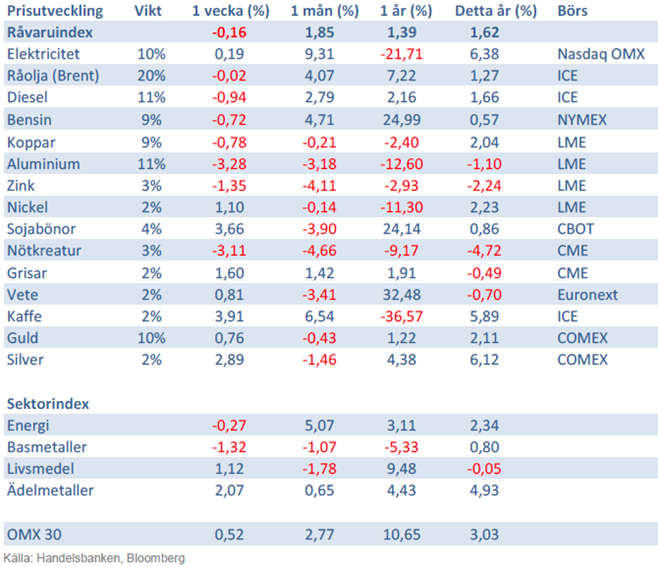
Handelsbankens råvaruindex består av de underliggande indexen för respektive råvara. Vikterna är bestämda till hälften från värdet av global produktion och till hälften från likviditeten i terminskontrakten.
[box]SHB Råvarubrevet är producerat av Handelsbanken och publiceras i samarbete och med tillstånd på Råvarumarknaden.se[/box]
Ansvarsbegränsning
Detta material är producerat av Svenska Handelsbanken AB (publ) i fortsättningen kallad Handelsbanken. De som arbetar med innehållet är inte analytiker och materialet är inte oberoende investeringsanalys. Innehållet är uteslutande avsett för kunder i Sverige. Syftet är att ge en allmän information till Handelsbankens kunder och utgör inte ett personligt investeringsråd eller en personlig rekommendation. Informationen ska inte ensamt utgöra underlag för investeringsbeslut. Kunder bör inhämta råd från sina rådgivare och basera sina investeringsbeslut utifrån egen erfarenhet.
Informationen i materialet kan ändras och också avvika från de åsikter som uttrycks i oberoende investeringsanalyser från Handelsbanken. Informationen grundar sig på allmänt tillgänglig information och är hämtad från källor som bedöms som tillförlitliga, men riktigheten kan inte garanteras och informationen kan vara ofullständig eller nedkortad. Ingen del av förslaget får reproduceras eller distribueras till någon annan person utan att Handelsbanken dessförinnan lämnat sitt skriftliga medgivande. Handelsbanken ansvarar inte för att materialet används på ett sätt som strider mot förbudet mot vidarebefordran eller offentliggörs i strid med bankens regler.
Analys
Sell the rally. Trump has become predictable in his unpredictability

Hesitant today. Brent jumped to an intraday high of $66.36/b yesterday after having touched an intraday low of $60.07/b on Monday as Indian and Chinese buyers cancelled some Russian oil purchases and instead redirected their purchases towards the Middle East due to the news US sanctions. Brent is falling back 0.4% this morning to $65.8/b.

It’s our strong view that the only sensible thing is to sell this rally. In all Trump’s unpredictability he has become increasingly predictable. Again and again he has rumbled about how he is going to be tough on Putin. Punish Putin if he won’t agree to peace in Ukraine. Recent rumbling was about the Tomahawk rockets which Trump threatened on 10 October and 12 October to sell/send to Ukraine. Then on 17 October he said that ”the U.S. didn’t want to give away weapons (Tomahawks) it needs”.
All of Trump’s threats towards Putin have been hot air. So far Trump’s threats have been all hot air and threats which later have evaporated after ”great talks with Putin”. After all these repetitions it is very hard to believe that this time will be any different. The new sanctions won’t take effect before 21. November. Trump has already said that: ”he was hoping that these new sanctions would be very short-lived in any case”. Come 21. November these new sanctions will either evaporate like all the other threats Trump has thrown at Putin before fading them. Or the sanctions will be postponed by another 4 weeks or 8 weeks with the appearance that Trump is even more angry with Putin. But so far Trump has done nothing that hurt Putin/Russia. We can’t imagine that this will be different. The only way forward in our view for a propre lasting peace in Ukraine is to turn Ukraine into defensive porcupine equipped with a stinging tail if need be.
China will likely stand up to Trump if new sanctions really materialize on 21 Nov. Just one country has really stood up to Trump in his tariff trade war this year: China. China has come of age and strength. I will no longer be bullied. Trump upped tariffs. China responded in kind. Trump cut China off from high-end computer chips. China put on the breaks on rare earth metals. China won’t be bullied any more and it has the power to stand up. Some Chinese state-owned companies like Sinopec have cancelled some of their Russian purchases. But China’s Foreign Ministry spokesperson Guo Jiakun has stated that China “oppose unilateral sanctions which lack a basis in international law and authorization of the UN Security Council”. Thus no one, not even the US shall unilaterally dictate China from whom they can buy oil or not. This is yet another opportunity for China to show its new strength and stand up to Trump in a show of force. Exactly how China choses to play this remains to be seen. But China won’t be bullied by over something as important as its oil purchases. So best guess here is that China will defy Trump on this. But probably China won’t need to make a bid deal over this. Firstly because these new sanctions will either evaporate as all the other threats or be postponed once we get to 21 November. Secondly because the sanctions are explicit towards US persons and companies but only ”may” be enforced versus non-US entities.
Sanctions is not a reduction in global supply of oil. Just some added layer of friction. Anyhow, the new sanctions won’t reduce the supply of Russian crude oil to the market. It will only increase the friction in the market with yet more need for the shadow fleet and ship to ship transfer of Russian oil to dodge the sanctions. If they materialize at all.
The jump in crude oil prices is probably due to redirections of crude purchases to the Mid-East and not because all speculators are now turned bullish. Has oil rallied because all speculators now suddenly have turned bullish? We don’t think so. Brent crude has probably jumped because some Indian and Chinese oil purchasers of have redirected their purchases from Russia towards the Mid-East just in case the sanctions really materializes on 21 November.
Analys
Brent crude set to dip its feet into the high $50ies/b this week

Parts of the Brent crude curve dipping into the high $50ies/b. Brent crude fell 2.3% over the week to Friday. It closed the week at $61.29/b, a slight gain on the day, but also traded to a low of $60.14/b that same day and just barely avoided trading into the $50ies/b. This morning it is risk-on in equities which seems to help industrial metals a little higher. But no such luck for oil. It is down 0.8% at $60.8/b. This week looks set for Brent crude to dip its feet in the $50ies/b. The Brent 3mth contract actually traded into the high $50ies/b on Friday.

The front-end backwardation has been on a weakening foot and is now about to fully disappear. The lowest point of the crude oil curve has also moved steadily lower and lower and its discount to the 5yr contract is now $6.8/b. A solid contango. The Brent 3mth contract did actually dip into the $50ies/b intraday on Friday when it traded to a low point of $59.93/b.
More weakness to come as lots of oil at sea comes to ports. Mid-East OPEC countries have boosted exports along with lower post summer consumption and higher production. The result is highly visibly in oil at sea which increased by 17 mb to 1,311 mb over the week to Sunday. Up 185 mb since mid-August. On its way to discharge at a port somewhere over the coming month or two.
Don’t forget that the oil market path ahead is all down to OPEC+. Remember that what is playing out in the oil market now is all by design by OPEC+. The group has decided that the unwind of the voluntary cuts is what it wants to do. In a combination of meeting demand from consumers as well as taking back market share. But we need to remember that how this plays out going forward is all at the mercy of what OPEC+ decides to do. It will halt the unwinding at some point. It will revert to cuts instead of unwind at some point.
A few months with Brent at $55/b and 40-50 US shale oil rigs kicked out may be what is needed. We think OPEC+ needs to see the exit of another 40-50 drilling rigs in the US shale oil patches to set US shale oil production on a path to of a 1 mb/d year on year decline Dec-25 to Dec-26. We are not there yet. But a 2-3 months period with Brent crude averaging $55/b would probably do it.
Oil on water increased 17 mb over the week to Sunday while oil in transit increased by 23 mb. So less oil was standing still. More was moving.

Crude oil floating storage (stationary more than 7 days). Down 11 mb over week to Sunday

The lowest point of the Brent crude oil curve versus the 5yr contract. Weakest so far this year.

Crude oil 1mth to 3mth time-spreads. Dubai held out strongly through summer, but then that center of strength fell apart in late September and has been leading weakness in crude curves lower since then.

Analys
Crude oil soon coming to a port near you

Rebounding along with most markets. But concerns over solidity of Gaza peace may also contribute. Brent crude fell 0.8% yesterday to $61.91/b and its lowest close since May this year. This morning it is bouncing up 0.9% to $62.5/b along with a softer USD amid positive sentiment with both equities and industrial metals moving higher. Concerns that the peace in Gaza may be less solid than what one might hope for also yields some support to Brent. Bets on tech stocks are rebounding, defying fears of trade war. Money moving back into markets. Gold continues upwards its strong trend and a softer dollar helps it higher today as well.

US crude & products probably rose 5.6 mb last week (API) versus a normal seasonal decline of 2.4 mb. The US API last night partial and thus indicative data for US oil inventories. Their data indicates that US crude stocks rose 7.4 mb last week, gasoline stocks rose 3.0 mb while Distillate stocks fell 4.8 mb. Altogether an increase in commercial crude and product stocks of 5.6 mb. Commercial US crude and product stocks normally decline by 2.4 mb this time of year. So seasonally adjusted the US inventories rose 8 mb last week according to the indicative numbers by the API. That is a lot. Also, the counter seasonal trend of rising stocks versus normally declining stocks this time of year looks on a solid pace of continuation. If the API is correct then total US crude and product stocks would stand 41 mb higher than one year ago and 6 mb higher than the 2015-19 average. And if we combine this with our knowledge of a sharp increase in production and exports by OPEC(+) and a large increase in oil at sea, then the current trend in US oil inventories looks set to continue. So higher stocks and lower crude oil prices until OPEC(+) switch to cuts. Actual US oil inventory data today at 18:00 CET.
US commercial crude and product stocks rising to 1293 mb in week 41 if last nights indicative numbers from API are correct.

Crude oil soon coming to a port near you. OPEC has lifted production sharply higher this autumn. At the same time demand for oil in the Middle-East has fallen as we have moved out of summer heat and crude oil burn for power for air-conditioning. The Middle-East oil producers have thus been able to lift exports higher on both accounts. Crude oil and condensates on water has shot up by 177 mb since mid-August. This oil is now on its way to ports around the world. And when they arrive, it will likely help to lift stocks onshore higher. That is probably when we will lose the last bit of front-end backwardation the the crude oil curves. That will help to drive the front-month Brent crude oil price down to the $60/b line and revisit the high $50ies/b. Then the eyes will be all back on OPEC+ when they meet in early November and then again in early December.
Crude oil and condensates at sea have moved straight up by 177 mb since mid-August as OPEC(+) has produced more, consumed less and exported more.

-

 Nyheter4 veckor sedan
Nyheter4 veckor sedanOPEC+ missar produktionsmål, stöder oljepriserna
-

 Nyheter2 veckor sedan
Nyheter2 veckor sedanGoldman Sachs höjer prognosen för guld, tror priset når 4900 USD
-

 Nyheter3 veckor sedan
Nyheter3 veckor sedanBlykalla och amerikanska Oklo inleder ett samarbete
-

 Nyheter3 veckor sedan
Nyheter3 veckor sedanGuld nära 4000 USD och silver 50 USD, därför kan de fortsätta stiga
-

 Nyheter2 veckor sedan
Nyheter2 veckor sedanLeading Edge Materials är på rätt plats i rätt tid
-

 Nyheter2 veckor sedan
Nyheter2 veckor sedanNytt prisrekord, guld stiger över 4000 USD
-

 Nyheter3 veckor sedan
Nyheter3 veckor sedanEtt samtal om guld, olja, koppar och stål
-

 Analys3 veckor sedan
Analys3 veckor sedanOPEC+ will likely unwind 500 kb/d of voluntary quotas in October. But a full unwind of 1.5 mb/d in one go could be in the cards


